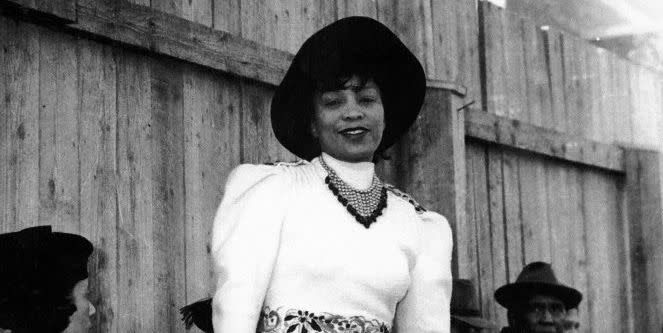12 Surprising Facts We Learned About Zora Neale Hurston

"Hearst Magazines and Yahoo may earn commission or revenue on some items through these links."
Sixty-three years ago, the world lost an indomitable force whose career is enviable and impact undeniable. In commemoration, PBS is airing a documentary called Zora Neale Hurston: Claiming a Space. The more you learn about Hurston, the more you realize how enigmatic and exceptional she was, succeeding at a time when options for poor Black women were limited. “If you are silent about your pain, they’ll kill you and say you enjoyed it,” said Hurston. Most readers know her famous books Their Eyes Were Watching God, Dust Tracks on a Road, Barracoon, and Mules and Men, but here are a few surprising facts about this Guggenheim-winning author.
1. Hurston was born in Notasulga, Alabama, in 1891, the fifth of eight children. When she was 3 years old, her Baptist preacher father moved the family to Eatonville, Florida. Established in 1887, it was the only all Black-incorporated town founded by freedmen. John Hurston served three terms as mayor of the town.
2. The writer’s mother died in 1904, when Hurston was 13, and John promptly remarried. Hurston, who had tumultuous relationship with her step-mother, joined siblings in Jacksonville, Florida. She attended boarding school but was forced to leave when her father ceased tuition payments. Hurston was passed from relative to relative, working odd jobs until she secured employment as maid for a singer in a Gilbert and Sullivan troupe, eventually landing in Maryland.
3. At 26, she subtracted 10 years off her age in order to attend Morgan Academy in Baltimore for free. Hurston graduated in 1918 and enrolled at Howard University. There she cofounded a campus newspaper, The Hilltop, was part of a drama group, and wrote poems and short stories including “John Redding Goes to Sea,” published in writer Alain Locke’s literary magazine Stylus. After working as a waitress and attending school part-time, she graduated with an associate’s degree but due to lack of funds could not proceed with her education.
4. Hurston moved to Harlem, where she quickly became a part of the New York literati, which included Langston Hughes, Jessie Redmon Fauset, and Countee Cullen, among others. In May 1925, she won four awards, the most at a literary awards dinner held by Opportunity magazine. There she met author Fanny Hurst, who hired her as an assistant. Hurston also made an impression on Annie Nathan Meyer, a founder of Barnard College, who offered her admittance and a scholarship to continue studies. In 1928, Hurston became the school’s first Black graduate.
5. At Barnard, the writer discovered an interest in anthropology. Her work received the attention of Franz Boas, known as “the father of modern anthropology,” who taught at Columbia University. After some fieldwork in Harlem, Hurston ventured to the South, researching and collecting data on cultural practices in Black communities. She secured a car loan, bought a pistol, and traveled alone until she chanced upon Langston Hughes in Alabama. Hughes assisted Hurston in her work, and together they returned to New York.
6. Philanthropist Charlotte Osgood Mason, a benefactor of Hughes’s and other Harlem Renaissance artists, supported Hurston to return to the South under a one-year contract. It was during this trip that Hurston interviewed Cudjoe Lewis, one of the last slaves to land in the United States on the Clotilda in 1860. Together with other formerly enslaved people, he founded African Town in Alabama. Hurston videotaped and interviewed Lewis. What resulted was the book Barracoon. Hurston rejected publishers’ requests to translate Lewis’s dialect to standard English, and as a result, the book went unpublished until 2018.
7. Traveling alone as a Black woman in the South was a dangerous endeavor, in addition to the difficulty of gaining the communities’ trust. Hurston fabricated a criminal history of bootlegging in order to assuage the suspicions of male workers at a lumber camp in Polk County, Florida. She would also read Langston Hughes poems to receptive audiences along her journeys.
8. Funded by the Guggenheim Foundation, Hurston traveled to the West Indies to study obeah practices. There she participated in four voodoo ceremonies, fully immersing herself in the religion and learning from its priests. Realizing the need to expand her research, she appealed to the foundation for more assistance and received a second fellowship.
9. In addition to the funded fieldwork, Hurston collected letters for a book on Black love, and documented dance songs and tales from the Bahamas. She also wrote the play The Great Day, which premiered on Broadway to great reviews in 1932.

You Don’t Know Us Negroes and Other Essays
amazon.com
10. In true Hurston grit, she won another scholarship, this time to pursue a PhD in anthropology at Columbia, but abandoned the program after a semester because she disagreed with the research direction the Rosenwald Foundation (which was funding her studies) insisted she take.
11. In a career spanning over 30 years, the prolific writer published four novels, an autobiography, two nonfiction books, short stories, plays, essays, and poems.
12. Hurston died in 1960, and her work languished in obscurity. In 1975, Alice Walker penned an essay for Ms. Magazine titled “In Search of Zora Neale Hurston,” which revived interest in the author and anthropologist’s work and life.
Hurston’s statement “I have the nerve to walk my own way, however hard, in my search for reality, rather than climb upon the rattling wagon of wishful illusions” fully encapsulates her life’s mantra. She forged her own path, defying everyone’s expectations but her own.
You Might Also Like
